General Thomas J. "Stonewall"
Jackson, and
Lexington, Virginia
By John T. Marck
Lexington, Virginia is located in
Rockbridge County, in the beautiful Shenandoah Valley of Virginia. It was seen
in 1716 by Virginia Governor Alexander Spottswood and his group of explorers,
known as the "Knights of the Golden Horseshoe." What they were gazing upon
would become one of America’s great "Passages West." For many future visitors,
it became their destination, rather than simply a route westward. Rockbridge
County, located about midway north to south in the Shenandoah Valley began
with its first settlement in the early 1730s. In 1777, the Virginia
Legislature created Rockbridge County named for the towering natural stone
bridge in the southern end of the county. The county seat was named Lexington,
after the Massachusetts town where the American Revolution began. Today,
Rockbridge County, with the towns of Lexington and Buena Vista has a
population of about 35,000.
Lexington, Virginia, has a very rich
heritage and is the home to several famous generals. It is also the home to
Washington and Lee University, and is also the home to the Virginia Military
Institute.
George Washington saved the school
from bankruptcy in 1796 with his gift of $50,000 in stock of the James River
Canal Company that was given to him by the State of Virginia. This gift
enabled the school to stay open, and today, still earns dividends for the
students.

The school second namesake was Robert
E. Lee, who in 1865, less than 6 months after the signing of the surrender of
the Confederate Army at Appomattox, rode his beloved horse, Traveller, down
the Main Street to assume the presidency of the school, then known as
Washington College. Under Lee’s leadership and influence, the school became a
university of national stature. Below, Traveller’s gravesite located outside
the Lee Chapel.
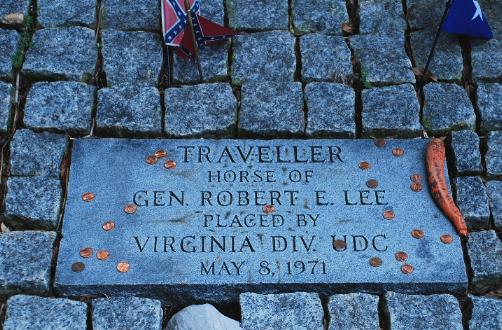
Lexington’s Virginia Military
Institute (VMI) claims the other two generals in the town’s heritage. Thomas
Jonathan "Stonewall" Jackson was a teacher at VMI, in natural philosophy
(physics) and artillery tactics for ten years prior to the Civil War. In
Lexington, besides teaching here, he also married, bought his home, farmed,
and was an active church member. He loved the town, calling it the "most
beautiful place that I remember of having ever seen."
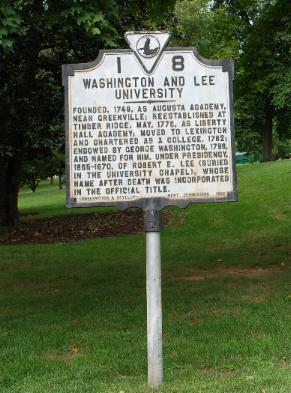
The town of Lexington has 45 historic
places of interest than can be visited by car or walking tours. These can be
divided into four areas: (1) Washington & Lee Walking Tour, (2) Virginia
Military Institute Walking Tour, (3) the Residential Walking Tour, and (4) its
various museums.
There are two areas of special
interest that of the final resting places of General Robert E. Lee and General
Thomas "Stonewall" Jackson.
Located on the campus of Washington
and Lee University is the Lee Chapel and Museum. The chapel (below) was built
in 1867 at the request and under the supervision of Robert E. Lee. As you
enter the chapel, at the altar, you will see the recumbent statue of General
Lee by Edward Valentine, flanked by Confederate battle flags. General Lee also
had his office here, which remains preserved much as he left it.
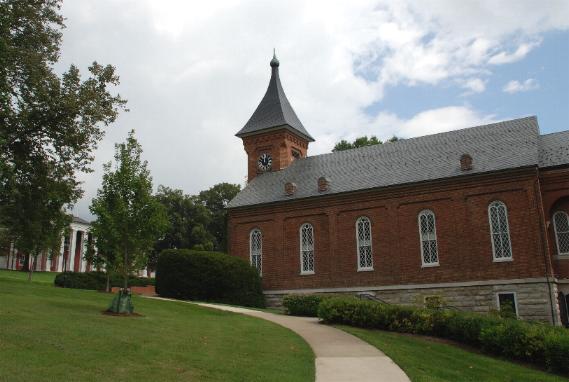
The recumbent statue of General
Robert E. Lee (Below) took 4 years to complete, and at the request of his
wife, shows the general lying as if sleeping, dressed in his Confederate
general’s uniform, together with his sword, with a blanket draped over him.
The weaves shown in the statue in the blanket are amazing as is the detail of
the general, his uniform and his sword.
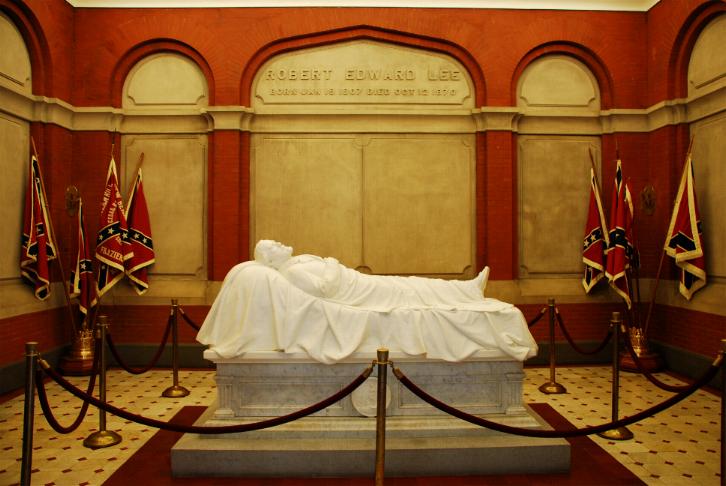

The many battle flags here are now
replicas, as the originals were taken and are now a part of the collection of
the Museum of the Confederacy in Richmond, Virginia.
In beginning a tour of Lexington, one
starts at the (1) Visitor Center, located at 106 East Washington Street. Here,
knowledgeable staff members can answer questions, and provide maps and
literature on the numerous areas of interest.
Next, at 101 East Washington Street
is the (2) Campbell House. Built by Alexander T. Sloan in 1844-45, he was a
prominent local hotelkeeper and the house served as his home. Today it houses
the Rockbridge County Historical Society.
Continuing on to 6 Randolph Street is
the (3) "Castle." It is believed to be one of the oldest buildings in town,
built in the early 1790s by Andrew Reid, the first Clerk of the Rockbridge
County Court.
At 8 East Washington Street is the
(4) Stonewall Jackson House. This was the only home of Confederate General
Thomas Jonathan "Stonewall" Jackson. It was built in 1800 and the stone
addition at the rear was added about 1848. Jackson and his second wife, Mary
Anna, and five of their six slaves lived in the house from 1859 to 1861 when
he departed to serve in the Confederacy during the Civil War. Following the
death of Jackson in 1863, the family remained in the house until 1906when the
Daughters of the Confederacy purchased it and developed it as the Jackson
Memorial Hospital. For the next 47 years it was the only hospital in
Rockbridge County. In 1954 the house was purchased by the Stonewall Jackson
Memorial, Inc., and opened to the public as a museum. The Historic Lexington
Foundation acquired it and completed the extensive restoration of the house
and garden in 1979.
The building located in Courthouse
Square (5) is the Former Rockbridge County Jail. It was designed by the
nationally known Philadelphia architect Thomas U. Walter who designed the U.S.
Capital dome. Until 1988 it was one of the oldest working jails in the
country.
At the corner of Washington and Main
Streets is the (6) Old Rockbridge County Courthouse. Built about 1897, it was
the fourth courthouse built in Lexington. It currently serves as offices for
Washington and Lee University.
At 23 North Main Street (7) is the
John Ruff House, built about 1811, for the John Ruff family and served as
their residence for the next 70 years. In the late 19th and early
20th centuries, this area was the center for African American
business and community activities. The top floor of the house served as the
headquarters for the local black Odd fellows Lodge.
The First Baptist Church (8) is
located at 103 North Main Street. This African-American church was built in
1894 and added to the Virginia Landmarks Register in 2006.
The Willson-Walker House (9) at 30
North Main Street was built about 1820 by Captain William walker, a local
merchant, post master and treasurer of Washington College. In 1911 it was
purchased by Harry Lee Walker, one of Lexington’s most prominent
African-Americans who ran his butcher shop here and sold his famous hickory
smoke0cured Virginia hams. Today it is a restaurant.
Located a 3 West Washington (10) is
the Alexander-Withrow House, built about 1789 by William Alexander. This is
one of the very few structures that survived the fire that leveled Lexington
in 1796. Located at a principal corner of the city, it served as the first
school, the first post office, and the first bank in the city. The exterior
was restored by the Historic Lexington Foundation, and today is an Inn.
The Lexington Presbyterian Church
(11) is at the corner of Main and nelson streets, and organized in 1789. The
present building was completed in 1845. Thomas "Stonewall" Jackson was an
active member here, becoming a deacon. The church was damaged by fire in 2000
but has been restored.
At 15 East Nelson Street (12) is the
Jordan House, t in the 1840s. In 1847 it was purchased by Colonel John Jordan,
one of the town’s prominent builders. Today is serves as a law office.
The Hopkins House (13) is at 120 west
Nelson Street, and is the only property in the city still owned by the family
that originally bought it from the town trustees about 1778.
Hopkins Green (14) at the corner of
Nelson and Jefferson Street, and the side yard of the Hopkins House, was
created by Historic Lexington Foundation as a public park and was recently
given to the city.
Washington and Lee University Tour
Continuing on is the Robert E. Lee
Memorial Episcopal church (15) built in 1883. General Lee had served as Senior
Warden of Lexington’s Grace Episcopal Church, and as such, just a few days
before his death in 1870, he approved plans for a new church building. General
Francis H. Smith, the first superintendent of VMI and a colleague, friend and
admirer of General Lee, was the principal founder of the church in 1840.
The Lee House (16) was build for
Robert E. Lee while he was president of Washington and Lee University. It has
served as the home of the president of W&L ever since. The large porch which
surrounds the house was provided for Mrs. Lee who was confined to a
wheelchair. At the side of the house is a garage that was once a stable for
General Lee’s famous horse, Traveller. General Lee died in a room on the first
floor of the house. It is not open to the public.
The Lee-Jackson House (17) was built
about 1842 for the then president of Washington College, Henry Ruffner. This
house one of the most interesting histories of any in Lexington. General
"Stonewall" Jackson married President George Junkin’s daughter Elinor here in
1853 and lived in the north wing. Her sister. Margaret Junkin Preston, a noted
Civil, War poetess also lived here. When General Lee became president of the
college in 1865, he and his family moved into the house before Lee House was
built. It is not open to the public.
The Morris House (18) is one of four
faculty homes that were built on the front campus that about 1842. Not
open to public.
Built in 1824, Washington Hall (19)
it established the benchmark for the subsequent development of the front
campus and is widely regarded as one of the most beautiful in the nation. In
1844, a wooden statue of George Washington, carved by local cabinetmaker
Matthew Kahle, was placed on top of the cupola. It is considered a wonderful
piece of folk art, and in 1992 a bronze replica replaced the wooden statue.
Reeves Center (20) was another
faculty home built in 1842. It is now the center for research and exhibition
of porcelain and paintings.
The Lee Chapel (21) was built inn
1867 and is outlined above herein.
Three International fraternities (22)
were founded in Lexington. A granite marker on Letcher Avenue honors Alpha Tau
Omega, Kappa Alpha Order, and Sigma Nu. Alpha Order and Sigma Nu have their
headquarters in Lexington.
Virginia Military Institute Walking Tour
The George C. Marshall Museum and
Liberty (23) was founded by the Marshall Foundation in 1953 at the suggestion
of President Truman. The building was dedicated in 1964 by President Johnson
and General Eisenhower to honor the memory of George C. Marshall, former Army
Chief of Staff, Secretary of State and Defense, and winner of the Nobel Peace
Prize.
The Superintendents Quarters (24) was
built about 1860, and all the VMI Superintendents have lived here. Not
open to the public.
The Commandants Quarters (25) was
built in 1852 and was the home of VMI professor Mathew Fontaine Maury,
"pathfinder of the Seas," a pioneer of oceanography. Not open to the
public.
The Barracks (26) was begun in 1851,
and is where the cadets live. The west arch is named for George C. Marshall;
the next arch is named for TJ "Stonewall" Jackson, who taught here. The statue
in front of the arch depicts Jackson surveying the field at Chancellorsville
during the Civil War. The cannons flanking the statue were cast in 1848
especially for VMI and were used by Jackson to teach military tactics. On the
east side of the Barracks are the Washington Arch and the George Washington
Statue. This was the original entrance to the Barracks. Not open to the
public.
The old Hospital (27) was built in
1848 and is the oldest VMI building. Built for a hospital for cadets, it has
been restored and today houses the office of the chaplain.
The Jackson Memorial Hall (28) was
built in 1915 and is named for Thomas Jonathan "Stonewall" Jackson. In the
hall is an oil painting that depicts the cadet charge at the battle of New
Market in 1864. It was painted by Benjamin West Clinedinst an 1880 graduate of
VMI. The flags around the hall represent the 26 states when VMI was founded in
1839.
On the lower level of the Jackson
Memorial is the VMI Museum (29).
The "Virginia Morning Her Dead,"
statue (30) honors the members of VMI Corps of Cadets who fought at the Battle
of New Market in1864. Ten cadets died and 47 were wounded, and six are buried
behind the monument. The statue is by Sir Moses Ezekiel, a New Market cadet.
Each May 15, a ceremony is held in memory of the New Market Cadets.
Residential Walking Tour
The homes listed herein (32-45) and
NOT open to the public except during special events.
(32) The Evergreen House, at 208 West
Nelson Street, was built about 1821 for Samuel McDowell Reid, who succeeded
his father Andrew Reid as clerk of the Rockbridge County Court. The house
remained in the Reid-White families until after World War II.
(33) The Rectory, located at 107 Lee
Avenue, was built in 1824 for Charles P. Dorman, a prominent lawyer, editor
and member of the Virginia general assembly. In 1854 the house became the
Rectory of the Grace (In 1903 the Robert E. Memorial) Episcopal Church. It was
purchased by Rev. (General) William N. Pendleton, who served as General Lee’s
Chief of Artillery during the Civil War.
(34) Also built about 1824 is
Beaumont, at 109 Lee Avenue. It was the home of Samuel Darst, who with his
partner, John Jordan, were active builders during the 1820s and constructed
some of Lexington’s finest buildings. The firm of Jordan-Darst did the
brickwork for Thomas Jefferson’s Monticello.
(35) Built about 1819 is The Pines,
at 111 Lee Avenue. This home was built for Benjamin Darst and later purchased
General William N. Pendleton when he retired as rector of the Episcopal
Church.
(36) At 110 Preston Street is the
Preston House, built in 1821 for Henry Ruffner, a longtime professor and later
president of Washington College. In 1844 it was purchased by J.T.L. Preston,
professor and leader at VMI. It was from this house that Preston’s wife,
Margaret Junkin Preston (known as the "poetess of the Confederacy") watched
and wrote about the burning of VMI by Union forces in 1864.
(37) The earliest buildings built in
Lexington along Jackson Avenue were part of the town’s first housing
development. The present houses, numbered, 301, 303, 305, 307, 309 and 311 are
part of "Godwin’s row," and were built in 1884.
(38) The Miley House is located at
108 White Street and was built about 1875 as the home of Michael Miley, the
noted 19th century photographer. He opened a studio in Lexington in
1866 and often photographed General Lee and other famous people who came to
Lexington to see him.
(39) Several houses from the Miley
House is the Edmondson-Penick House at 108 White Street. It was built in 1867
for Judge James Kerr Edmondson, who served as circuit court judge at age 25,
and was Lexington’s first post-war mayor, and a judge of the Rockbridge County
Court, and a member of the Virginia House of Delegates, and a trustee of
Washington and Lee University.
(40) The Manse, at 6 White Street was
built about 1848, partly from brick salvaged from the old Presbyterian Church
after the present church was completed. The old church (1797) stood in the
cemetery on South Main Street. Its first occupant was Dr. William S. White,
for whom White Street was named.
(41) The White-Davidson House at 309
South Jefferson Street was built about 1854 for George White.
(42) Nearby at 303 South Jefferson
Street are the Gables, built in 1851 for John Myers, a successful local
merchant.
(43) Silverwood, at 505 South Main
Street, was built in 1858 for General E.F. Paxton, a commander of the
Stonewall Brigade during the Civil War.
(44) Continuing down South Main to
601 is the McElwee House, built in 1858 for Rev. William M. McElwee, a
prominent clergyman. When Robert E. Lee was president of Washington College
(1865-1870) he often visited the McElwees at this house which was then located
on the outskirts of town.
(45) The Stonewall Jackson Memorial
Cemetery is located on South Main Street, and grew around the Lexington
Presbyterian Church, built on the southern end of town in 1789. The site of
the old church can be seen in the cemetery beside Main Street near the Preston
family plot where its iron fence and gate are located. Two Virginia governors,
veterans of the Revolutionary War, and more than 100 Confederate veterans are
buried here, as a General Thomas Jonathan "Stonewall’ Jackson, pictured below.
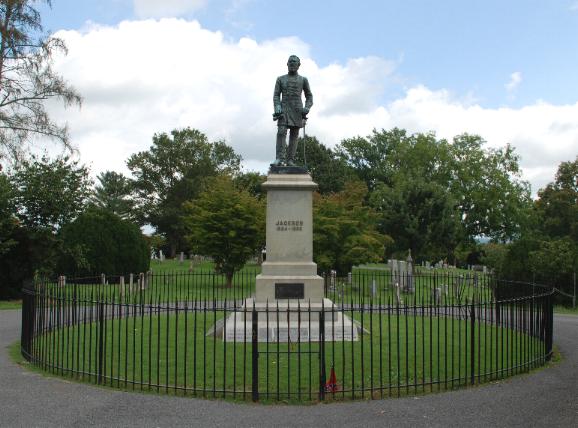
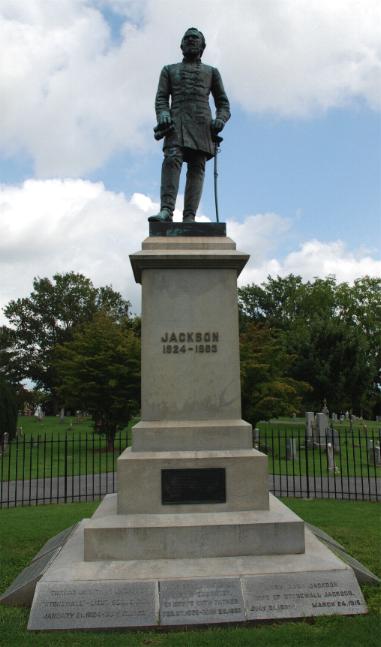
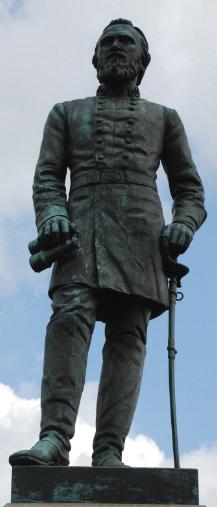
Copyright © 1992-2022 (2012) by John T. Marck. Photographs © 2012 by
John T. Marck. Information and map for this article, in greatest part, is
taken directly from the Lexington and Rockbridge Area Tourism Development,
located at the Visitor’s Center at 106 East Washington Street., from their
publication, "Historic Lexington, Virginia, Where Memories Are Made –
Walking Tours. Information and photographs may not be used or reproduced
without permission.

